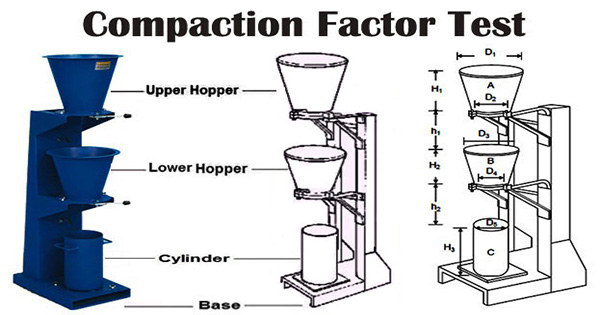Details of compaction factor test

There are different types of tests which can be conducted to compute the workability of fresh concrete. Given below, some most recognized methods to check workability of concrete.
a) Slump Test
b) Compaction Factor Test
c) Flow Test
d) Vee-Bee Test
e) Kelly Ball Test
In this construction article, detail information is given on compaction factor test.
Synopsis of Compaction Factor Test
- Slump cone test may not be always accurate for rigid or rough concrete. Here, lies the importance of compaction factor test.
- The compaction factor test highlights the behaviour of fresh concrete under the operation of outer force.
- Under this test, the workability of concrete is found with the compaction acquired through a free fall of concrete.
- The value of compaction factor is 0.75 to 0.8 with adherence to IS 456-2000.
- It is not recommended for concrete having very low workability of 0.7 or under.
Method of compaction Factor Test
The sample of concrete is arranged in top most part of the hopper.
After that, the door of hopper is exposed. The sample falls into lower hopper that fills it up to overflowing.
The trap door of the lower hopper is then exposed and the sample drops into the cylinder that is also loaded to overflowing.
A trowel is used to eliminate the excess concrete from the top of the cylinder.
After that, the exterior surface of cylinder is dried and cleansed.
Then the weight of the cylinder is taken and documented as weight of partly compacted concrete.
After that, the cylinder is further loaded with concrete in layers not surpassing 50 mm in thickness. With the help of a tampering rod, every layer is entirely compacted.
The weight of the cylinder is further taken once the exterior surface of the cylinder is dried and cleansed. This weight is documented as the weight of completely compacted concrete.
By applying the following formula, the compaction factor is then measured:-
Compacting factor = weight of partly compacted concrete / weight of completely compacted concrete.

